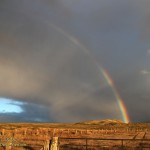Today the Earth is furthest from the Sun, a point called apehelion. We will be about 152,096,000km (94,508,000miles) from the Sun. Compare this to the 147,099,000km (91,403,000miles) we were be at perihelion on January 3rd, a difference of about 4,996,000km (3,104,000miles) occurring throughout one orbit.
It may seem odd that we are actually at the furthest for the middle of northern summer, you just have to remember that proximity to the Sun is not the cause of the seasons. The seasons are caused by the axial tilt of the Earth, creating short and long days throughout the year, with a resulting change in the angle and intensity of the sunlight.
| 2014 Solstices and Equinoxes | ||||
|---|---|---|---|---|
| UT | HST | |||
| Perihelion | Jan 4 | 05:59UT | Jan 3 | 19:59HST |
| Vernal Equinox | Mar 20 | 16:57UT | Mar 20 | 06:57HST |
| Summer Solstice | Jun 21 | 10:52UT | Jun 21 | 00:52HST |
| Apehelion | Jul 3 | 22:59UT | Jul 3 | 12:59HST |
| Autumnal Equinox | Sep 23 | 02:30UT | Sep 22 | 16:30HST |
| Winter Solstice | Dec 21 | 23:03UT | Dec 21 | 13:03HST |
| Source: NASA Sky Calendar | ||||

